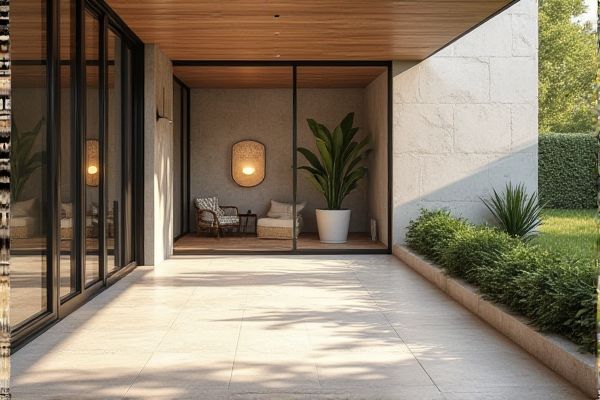
Ceramic tiles offer affordability and a wide range of designs, making them suitable for terraces with moderate foot traffic and less exposure to harsh weather. Porcelain tiles, being denser and more water-resistant, provide superior durability and longevity for outdoor terraces subjected to heavy use and extreme conditions; explore the rest of this article to discover which option best fits Your terrace needs.
Table of Comparison
| Feature | Ceramic Tiles | Porcelain Tiles |
|---|---|---|
| Material | Clay-based, fired at lower temperatures | Denser clay, fired at higher temperatures |
| Durability | Moderate, suitable for light outdoor use | High, ideal for heavy outdoor and terrace use |
| Water Absorption | Higher (up to 7%), less water-resistant | Low (<0.5%), highly water-resistant |
| Slip Resistance | Varies, generally less slip-resistant | Better slip resistance, especially textured varieties |
| Maintenance | Easy, but may require sealing outdoors | Low maintenance, resists stains and moisture |
| Cost | Lower cost, budget-friendly | Higher cost, premium quality |
| Suitability for Terrace | Suitable for covered terraces | Best choice for open or exposed terraces |
Introduction to Terrace Tiling: Ceramic vs Porcelain
Ceramic and porcelain tiles are popular choices for terrace tiling due to their durability and aesthetic appeal. Porcelain tiles offer higher density, lower water absorption rates below 0.5%, and greater resistance to outdoor elements compared to ceramic tiles, making them ideal for terraces exposed to moisture and temperature fluctuations. Ceramic tiles are more porous and typically less expensive, suited for covered or less exposed terrace areas where heavy wear and moisture are minimal.
Material Composition: Key Differences
Ceramic tiles are primarily made from red or white clay fired at lower temperatures, resulting in a more porous and less dense material, while porcelain tiles utilize finer, denser clay fired at higher temperatures for enhanced durability and water resistance. Porcelain tiles typically contain a higher percentage of silica and kaolin, contributing to their strength and making them more suitable for outdoor terraces exposed to variable weather conditions. These compositional differences directly impact the performance, with porcelain offering superior hardness, lower water absorption (usually less than 0.5%), and greater resistance to frost and wear compared to traditional ceramic tiles.
Durability and Strength Comparison
Porcelain tiles exhibit superior durability and strength compared to ceramic tiles, making them more suitable for outdoor terraces exposed to heavy foot traffic and harsh weather conditions. Porcelain's dense composition and low water absorption rate enhance resistance to cracks, scratches, and frost damage. Ceramic tiles, while less dense and more porous, are more prone to chipping and wear under intensive use, limiting their longevity on outdoor terraces.
Weather Resistance and Outdoor Performance
Porcelain tiles offer superior weather resistance and outdoor performance compared to ceramic tiles, making them ideal for terraces exposed to harsh climates. Porcelain's low porosity and dense composition prevent water absorption, reducing risks of cracking during freeze-thaw cycles and making it highly durable against rain, snow, and UV exposure. Your terrace will benefit from porcelain's slip resistance and stain durability, ensuring long-lasting aesthetic appeal and safety in outdoor environments.
Slip Resistance and Safety Factors
Porcelain tiles offer superior slip resistance compared to ceramic tiles due to their denser composition and lower porosity, making them ideal for terrace applications where safety is critical. The enhanced durability and moisture resistance of porcelain minimize the risk of slipping when surfaces are wet or exposed to outdoor elements. Ceramic tiles, while aesthetically versatile, tend to absorb more water and can become slippery when wet, requiring additional anti-slip treatments for safe terrace use.
Design, Colors, and Texture Options
Ceramic tiles for terraces offer a wide range of design and color options, including earthy tones and traditional patterns, with a smooth to slightly textured surface suitable for moderate foot traffic. Porcelain tiles provide enhanced durability and resistance to weather, available in sleek, contemporary designs and an extensive palette from neutral shades to vibrant colors, featuring a finer, denser texture that mimics natural stone or wood. Both materials allow versatile customization, but porcelain's denser composition ensures longer-lasting color retention and texture stability in outdoor environments.
Installation Process and Considerations
Ceramic tiles generally offer a simpler installation process for terraces due to their lighter weight and ease of cutting, which reduces labor time and costs. Porcelain tiles require a more precise substrate preparation and stronger thin-set adhesive because of their density and low porosity, enhancing durability and water resistance on outdoor terraces. Your choice impacts not only the installation complexity but also long-term maintenance and performance under weather exposure.
Maintenance and Cleaning Requirements
Porcelain tiles for terraces offer superior stain resistance and require less frequent sealing compared to ceramic tiles, making maintenance easier and more cost-effective. Ceramic tiles, while more porous, need regular sealing and more careful cleaning to prevent water absorption and surface damage. Both materials benefit from routine sweeping and mopping with mild detergents, but porcelain's density ensures durability against outdoor elements with minimal upkeep.
Cost Analysis: Ceramic vs Porcelain for Terraces
Ceramic tiles generally cost less than porcelain tiles, making them a budget-friendly option for terrace flooring. Porcelain tiles, though pricier, offer superior durability, water resistance, and low maintenance, which can reduce long-term replacement and repair expenses. Investing in porcelain tiles for terraces can provide better value over time due to their enhanced performance in outdoor conditions.
Which Tile is Best for Your Terrace?
Porcelain tiles are denser and more durable than ceramic tiles, making them highly resistant to moisture, frost, and heavy foot traffic, which is ideal for terraces exposed to varying weather conditions. Ceramic tiles are more affordable and offer a wide range of designs but are more porous and less durable, requiring extra sealing and maintenance outdoors. Your choice should depend on the climate, budget, and desired longevity, with porcelain generally providing superior performance for terrace applications.
 homyna.com
homyna.com